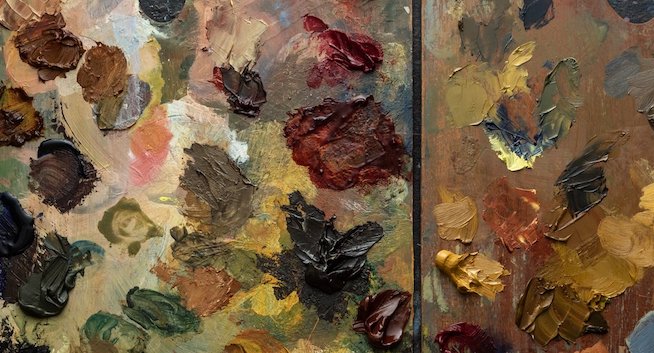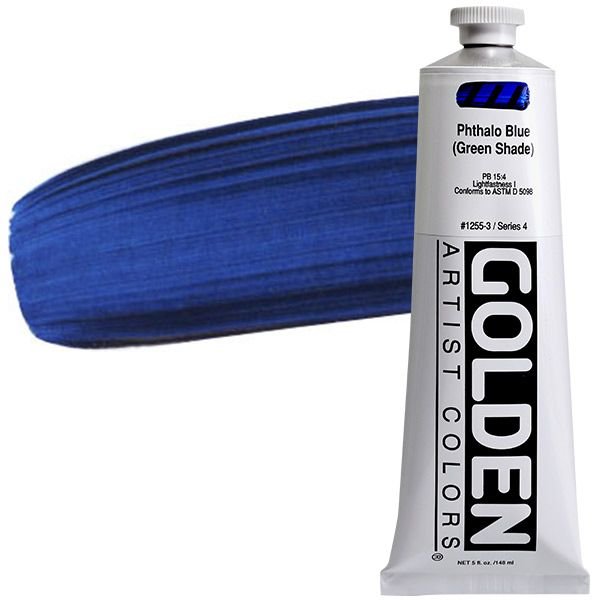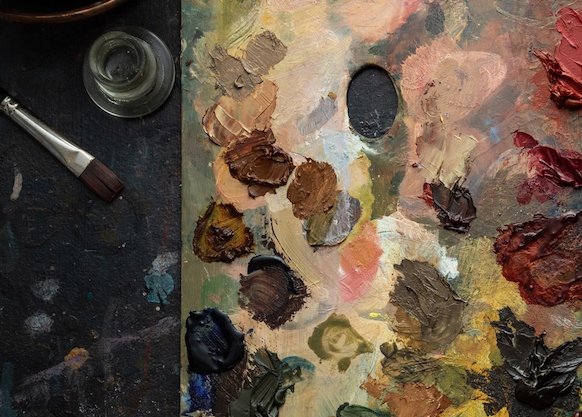What Are The Best Colors to Buy for Color Mixing?
Have you ever felt overwhelmed with the many options of colors you can buy in the store? Have you ever wondered why there are 5 different choices for reds and 4 different types of blue? In this article, I will break down color and give you the few colors you need to make almost any color under the sun.
In my years of working with students, I find that many don’t spend time studying color theory, and they often get frustrated when their colors turn to mud, or they waste a lot of paint trying to achieve that perfect color. Below you will find some crucial color mixing tips, and a list of what paint colors you need to buy for the results.
Why Are You Getting Mud?

Image from Jacksonart.com
First, when you get an un-purposeful mud color in your paintings, it means that you have mixed too many colors into one, to the point that the saturation of the color is reduced to a neutral. The way that you achieve neutral browns (purposely) is to mix the opposites on the color wheel together—for example, blue and orange. Mixing mud can be frustrating if it’s not what you want. Here are some general rules to make color mixing easy.
7 Rules of Color Mixing
Color theory is a huge topic of study, and it’s hard to go into all the details in one article online. Therefore, I listed out 7 vital tips so that you can improve your color mixing skills today! Here they are:
-
To Lighten A Color, Add a Lighter Color Such as Yellow, or White
-
To Darken A Color, Add a Darker Color Such as Purple, or Black
-
To Avoid Unintentional Browns, Don’t Mix Colors Opposite on the Color Wheel
-
Try to Mix Warm Colors with Warm, And Cool Colors With Cool to Avoid Mud
-
If You Want a Light Color, Add SMALL Amounts of the Darker Color So it Doesn’t Darken Too Fast
-
If You Have a Large Amount of A Color You Want to Lighten, Remove a Small Amount of That Color and Add White Directly to It
-
Try to Reduce Your Palette To Only 3 Colors (Not Including Black and White)
What Colors to Buy for Color Mixing
Now that you understand some best practices for mixing color, let’s review what colors you should have in your studio. You don’t need to buy every color in the store. If you look at the paint tube, it will tell you the pigments used to make that color. If it’s just one color, then that’s a good one to buy because you can’t mix that color. If it’s more than one color, then in most cases you can make the color yourself. However, it is useful to have the list of colors below so you can more easily and quickly mix the color you desire.

List of the Acrylic Colors You Need in Your Studio
If you want to avoid overwhelm, I recommend purchasing the below colors. They are important because they represent the primary and secondary colors. You can’t mix a primary color because it’s a single pigment, and it’s always good to keep secondaries on hand for accurate color mixing. You also need black and Titanium White. Titanium White is an opaque color (not see-through), so it’s a standard for color mixing and will lighten colors quickly. Zinc White, on the other hand, is a semi-transparent white, and you will have to use ALOT of the paint to lighten your colors. Zinc White is nice to have, however, if you want to create translucent layers of paint.
Must-Have Colors for Color Mixing
-
Cadmium Lemon Yellow or Hansa Yellow Light
-
Quinacridone Crimson or Cadmium Red Medium
-
Phthalo Blue (get green shade if there’s an option)
-
Viridian or Phthalo Green (get blue shade if there’s an option)
-
Dioxazine Purple
-
Cadmium or Vat Orange
-
Bone or Ivory Black
-
Titanium White
Additional Important Colors
-
Cadmium Red Light
-
Yellow Ochre
-
Burnt Sienna
-
Burnt Umber
-
Quniacridone Violet
-
Ultramarine Blue
- Permanent Green Light
There you have it! Try out these colors and put some of the above tips into practice in your studio, and I know you will experience more ease with color mixing. If you want to learn more about color, check out my online course, Abstraction Beyond Boundaries: Color & Composition.
ABOUT ANDREA CERMANSKI
I am an artist out of Santa Fe, New Mexico who has been painting for almost 30 years. I love to teach first-timers as well as experienced painters who need a creative reboot. My work has been displayed in several galleries around the country, and I have a Bachelor’s in Art History, a Master’s in Art Education, and had my work in a show juried by Judy Chicago. The idea of getting more people painting makes me light up as I want to inspire more people to express their creative selves and tap into a place of joy and calm.
WANT TO LEARN MORE?
- Subscribe and get a FREE PDF explaining How to Use My 5 Favorite Mediums
- Check out My Online Painting Course & Group Coaching Programs
- Read More Painting Tips Blog Posts
- Learn About 3-Day Painting Retreats in Santa Fe
- Check out My Paintings & Art Prints for Sale
- Follow me on Youtube, Instagram, or Pinterest
